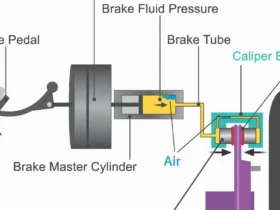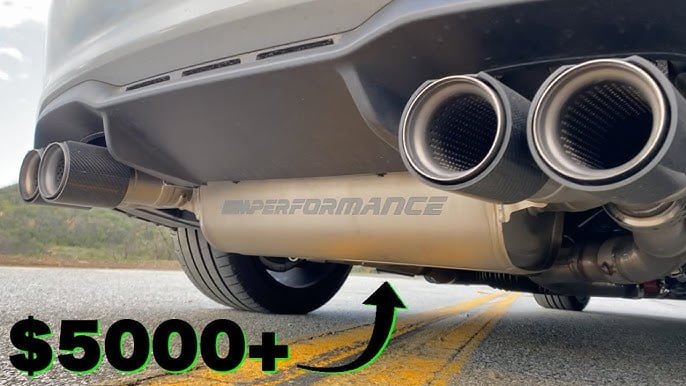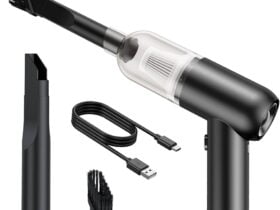Learn the difference between performance car exhaust vs stock for better horsepower, sound, and efficiency. Find the best option for your vehicle.
Performance car exhaust and stock exhaust systems serve distinct purposes. Performance exhausts enhance horsepower and torque, offering a more aggressive sound. They use high-quality materials like stainless steel, which resist corrosion and improve longevity. On the other hand, stock exhausts focus on reducing noise and emissions to meet regulatory standards.
They are often made from less durable materials like mild steel. Choosing between the two depends on your priorities. Performance enthusiasts may prefer the benefits of an upgraded exhaust, while everyday drivers might opt for the reliability and compliance of stock systems. Evaluate your needs to make the best choice.

Credit: www.bmwblog.com
Stock Exhaust Systems
Stock exhaust systems come pre-installed in vehicles. They are designed to meet regulatory standards and balance performance, emissions, and cost. These systems are the default option for most cars.
Design And Materials
Stock exhaust systems are typically made from mild steel or aluminumized steel. These materials are chosen for their cost-effectiveness and durability. The design usually includes a series of tubes and a muffler to reduce noise and emissions.
These systems are often configured to optimize fuel efficiency and reduce emissions. They are not usually geared towards enhancing performance.
| Material | Durability | Cost |
|---|---|---|
| Mild Steel | Moderate | Low |
| Aluminized Steel | High | Moderate |
Pros And Cons
Pros:
- Lower cost compared to performance exhausts
- Designed to meet emission regulations
- Quieter operation due to effective mufflers
Cons:
- Limited performance enhancement
- Heavier than performance exhausts
- Typically made from less durable materials
In summary, stock exhaust systems are budget-friendly and meet legal standards. They are ideal for daily commutes but fall short in performance enhancements.
Credit: g20.bimmerpost.com
Performance Exhaust Systems
Performance exhaust systems are designed to enhance car performance. They improve horsepower and engine efficiency. These systems replace stock exhausts, providing a louder sound and better gas flow.
Types Of Performance Exhausts
Different types of performance exhausts are available. Each type offers unique benefits.
| Type | Benefits |
|---|---|
| Cat-Back | Increases horsepower and torque |
| Axle-Back | Improves sound and appearance |
| Header-Back | Maximizes performance and efficiency |
Key Features
Performance exhaust systems have several key features:
- Material: Made from stainless steel or aluminum
- Piping: Larger diameter pipes for better gas flow
- Mufflers: Designed to reduce backpressure
- Sound: Provides a deeper and louder exhaust note
These features make performance exhausts a popular choice. They enhance both sound and performance.
Performance Gains
Switching from a stock exhaust to a performance car exhaust can provide significant performance gains. These upgrades are not just for show; they offer real improvements in horsepower, torque, and fuel efficiency.
Horsepower And Torque
A performance car exhaust can dramatically increase your vehicle’s horsepower and torque. This is achieved by reducing back pressure and improving the exhaust flow. Better exhaust flow allows the engine to breathe more efficiently.
- Increased horsepower
- Enhanced torque
- Improved throttle response
For example, a performance exhaust might add up to 20 horsepower. This makes your car faster and more powerful.
Fuel Efficiency
Upgrading to a performance exhaust can also improve fuel efficiency. Better exhaust flow means the engine uses fuel more effectively. This results in fewer trips to the gas station.
| Exhaust Type | Fuel Efficiency Gain |
|---|---|
| Stock Exhaust | 0% |
| Performance Exhaust | 5-10% |
With a performance exhaust, you could see up to a 10% improvement in fuel economy. This not only saves money but also reduces your car’s carbon footprint.
Sound And Aesthetics
Choosing between a performance car exhaust and a stock exhaust can be tough. Both options offer distinct advantages. This section focuses on sound and aesthetics. Learn how each option affects your car’s look and feel.
Acoustic Differences
A performance car exhaust changes your car’s sound. It makes it louder and more aggressive. This is because of the different materials and designs used.
Stock exhausts are quieter. They are designed to reduce noise. This makes them more suitable for daily driving.
Below is a table that summarizes the key differences:
| Exhaust Type | Sound Level | Suitability |
|---|---|---|
| Performance Exhaust | Loud, Aggressive | Racing, Show Cars |
| Stock Exhaust | Quiet, Subtle | Daily Driving |
Visual Appeal
Performance car exhausts often look more stylish. They come with chrome tips and polished finishes. This makes them stand out visually.
Stock exhausts are usually simpler. They have a more basic design. This makes them less eye-catching but functional.
Here are some key points about visual appeal:
- Performance Exhaust: Chrome tips, polished finishes, unique designs.
- Stock Exhaust: Basic design, functional, less attention-grabbing.
Choosing the right exhaust depends on your personal preference. Do you want a louder, more stylish look? Or a quieter, functional design?
Installation Process
Installing a performance car exhaust can differ greatly from installing a stock exhaust. Understanding the installation process helps you decide whether to tackle the job yourself or hire a professional. This guide will break down the essentials to get your car sounding and performing better.
Diy Vs. Professional Installation
Choosing between DIY and professional installation is crucial. If you are handy with tools, you might opt to do it yourself. A DIY installation can save money and give you a sense of accomplishment.
Here are some benefits and drawbacks of DIY installation:
- Cost-effective: No labor charges
- Learning experience: Gain hands-on knowledge
- Time-consuming: May take several hours
- Risk of errors: Potential for mistakes
For those less experienced, professional installation is a safer bet. Professionals have the skills and tools to do the job right the first time.
Consider these points for professional installation:
- Expertise: Experienced technicians
- Efficiency: Faster completion time
- Warranty: Often includes a guarantee
- Cost: Higher expense due to labor
Required Tools
The tools needed for exhaust installation vary based on whether you choose a performance or stock exhaust. Below is a table summarizing the required tools for each type:
| Tool | Performance Exhaust | Stock Exhaust |
|---|---|---|
| Socket Wrench Set | Required | Required |
| Jack Stands | Required | Optional |
| Torque Wrench | Required | Optional |
| Rust Penetrant Spray | Optional | Optional |
| Exhaust Hangers | Required | Optional |
To install a performance exhaust, you’ll need a more extensive toolset. Stock exhaust installations are generally simpler and may require fewer tools.
Below is a more detailed list of tools for a DIY performance exhaust installation:
- Socket Wrench Set: Essential for loosening and tightening bolts
- Jack Stands: Necessary for safely lifting the car
- Torque Wrench: Ensures bolts are tightened to the correct specification
- Rust Penetrant Spray: Helps loosen old, rusted bolts
- Exhaust Hangers: Needed to support the new exhaust system
Having the right tools makes the job smoother and ensures a secure installation.
Legal And Environmental Considerations
Choosing between a performance car exhaust and a stock exhaust involves more than just performance and sound. Legal and environmental considerations play a crucial role in this decision. Let’s explore these in detail.
Noise Regulations
Performance exhausts often produce louder sounds. This can be exciting for car enthusiasts. Yet, many regions have strict noise regulations. Exceeding the allowed decibel levels can lead to fines or penalties. Always check your local laws before installing a performance exhaust.
Here’s a quick comparison:
| Exhaust Type | Average Noise Level (dB) | Compliance |
|---|---|---|
| Performance Exhaust | 90-100 dB | May exceed limits |
| Stock Exhaust | 70-80 dB | Usually compliant |
Emission Standards
Emission standards are vital for reducing pollution. Performance exhausts may affect your car’s emissions. They can sometimes increase the output of harmful gases. This can make your vehicle fail emission tests.
Stock exhausts are designed to meet strict emission standards. They ensure your car stays environmentally friendly. When considering an upgrade, it’s essential to check if the performance exhaust is compliant with emission laws in your area.
Consider the following points:
- Performance exhausts may need additional equipment like catalytic converters.
- Stock exhausts usually come with built-in emission control devices.
Ensuring compliance with these standards is not just legal. It’s also a step towards a greener planet.
Cost And Value
Choosing between a performance car exhaust and a stock exhaust involves considering cost and value. Both options offer unique benefits and drawbacks. Understanding the financial implications helps make an informed decision.
Initial Investment
Upgrading to a performance car exhaust often requires a higher initial investment. Prices vary based on brand, material, and design. On the other hand, a stock exhaust is usually included in the car’s original cost, making it a more budget-friendly option.
| Exhaust Type | Typical Cost Range |
|---|---|
| Performance Exhaust | $500 – $2000 |
| Stock Exhaust | Included with vehicle |
Long-term Benefits
A performance exhaust can offer long-term savings. These systems often enhance fuel efficiency. Better airflow leads to less fuel consumption. Additionally, they usually have a longer lifespan compared to stock systems.
Stock exhausts are designed for general use. They may not offer the same longevity or efficiency. Replacing a stock exhaust more frequently can add up over time.
- Fuel Efficiency: Performance exhausts improve it.
- Lifespan: Performance exhausts last longer.
- Replacement Frequency: Stock exhausts need more frequent replacements.
Considering cost and value involves weighing initial and long-term expenses. Each option has its pros and cons. Choose based on your needs and budget.
Choosing The Right Exhaust
Choosing the right exhaust system can be challenging. It impacts your car’s performance, sound, and fuel efficiency. Let’s explore key factors and popular brands to help you decide.
Factors To Consider
- Performance: Performance exhausts improve horsepower and torque.
- Sound: Performance exhausts offer a louder, sportier sound.
- Material: Stainless steel exhausts last longer. They resist rust.
- Installation: Some exhausts are easy to install. Others need professional help.
- Cost: Performance exhausts are more expensive than stock ones.
Popular Brands
| Brand | Features | Price Range |
|---|---|---|
| MagnaFlow | Great sound, stainless steel, improved performance | $$$ |
| Flowmaster | Distinct sound, durable, good for muscle cars | $$ |
| Borla | High quality, aggressive sound, long-lasting | $$$$ |
Choosing the right brand depends on your needs. Consider your budget and desired features. This helps you make the best choice for your car.

Credit: www.m3post.com
Frequently Asked Questions
What Is A Performance Car Exhaust?
A performance car exhaust enhances engine efficiency and sound, improving horsepower and overall driving experience.
How Does Stock Exhaust Differ?
Stock exhausts are designed for comfort, compliance, and cost-effectiveness, often limiting performance and sound quality.
Why Upgrade To A Performance Exhaust?
Upgrading boosts horsepower, torque, and fuel efficiency, while providing a more aggressive and appealing exhaust note.
Is A Performance Exhaust Louder?
Yes, performance exhausts are generally louder, producing a deeper, more aggressive sound compared to stock exhausts.
Does A Performance Exhaust Improve Fuel Efficiency?
Yes, it can improve fuel efficiency by optimizing exhaust flow and reducing engine strain.
Are Performance Exhausts Street Legal?
Legality varies by region. Check local laws and regulations to ensure compliance with noise and emissions standards.
Conclusion
Choosing between a performance car exhaust and stock depends on your needs. Performance exhausts boost power and sound. Stock exhausts offer reliability and lower costs. Consider your priorities and budget before deciding. Both options have their benefits. Make an informed choice to enhance your driving experience.












Leave a Reply